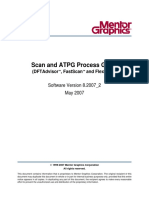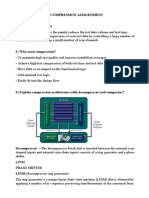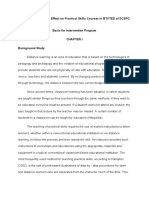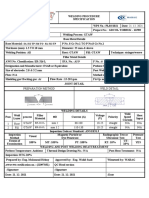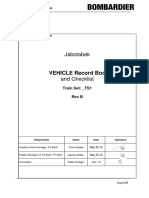100%(1)100% found this document useful (1 vote)
2K viewsInterview Questions Related To Scan, ATPG, EDT and Simulation
This document contains 38 interview questions related to topics in digital design test such as scan insertion, automatic test pattern generation (ATPG), embedded deterministic test (EDT), and simulation. The questions cover areas like the blocks and design features the candidate has worked with, how scan insertion and EDT were performed, techniques for improving test coverage, resolving issues found during ATPG and simulation, and purposes of different types of simulation.
Uploaded by
Siva SreeramdasCopyright
© © All Rights Reserved
Available Formats
Download as PDF, TXT or read online on Scribd
100%(1)100% found this document useful (1 vote)
2K viewsInterview Questions Related To Scan, ATPG, EDT and Simulation
This document contains 38 interview questions related to topics in digital design test such as scan insertion, automatic test pattern generation (ATPG), embedded deterministic test (EDT), and simulation. The questions cover areas like the blocks and design features the candidate has worked with, how scan insertion and EDT were performed, techniques for improving test coverage, resolving issues found during ATPG and simulation, and purposes of different types of simulation.
Uploaded by
Siva SreeramdasCopyright
© © All Rights Reserved
Available Formats
Download as PDF, TXT or read online on Scribd
You are on page 1/ 1
Interview Questions Related to Scan,ATPG,EDT and simulation
1. What have you done so far in DFT?
2. How many blocks was there in your last project and what were the flop counts?
3. How many blocks have you handled in the last project,how many clocks was there in
your block,how were you controlling the clock and how many OCC was there?
4. What were the clock frequencies for stuck-at and TDF?
5. What all DRC’s you got during scan insertion and how you handled that?
6. Have you done any test point insertion during scan insertion and what was that?
7. How many scan pins was there in your block and what was the chain length before
compression?
8. Have you done EDT ?How did you decide the compression ratio or maximum internal
chain length?
9. Why do we use terminal lock up?
10. Why are we going for synthesis after doing EDT?
11. Have you got any DRC’s during EDT and how you handled that?
12. How have you handled OCC flops during compression?
13. What was the targeted test coverage for your block and were you able to get that?
14. What is the optimal input pattern set for AND gate to detect all stuck-at faults ?
15. How were you getting a capture pulse in an at-speed test?
16. How can we control the maximum number of capture pulses that we get from OCC?
17. What is NCP?Why do we use this?
18. What is a wrapper cell?
19. Have you used a Wrapper cell and why?
20. Atspeed coverage is always less than STUCK-at coverage. Why?
21. How did you improve test coverage and what was the initial test coverage?
22. What happens if you are getting DRC’s during ATPG ,Can we resolve it here and what
is the impact of this on test coverage and ATPG run time?
23. What was the ATPG run time for your block and how many patterns were generated?
24. Two flops will have the same values during shift. What's the effect of it?
25. Why do we need simulation?
26. EDT bypass is passing. EDT chain patterns are failing. What could be the reasons?
27. Have you got any simulation mismatches?
28. Setup violations are there in your design. Which patterns would fail? (s@ or @speed?)
29. Hold violations are there. Which patterns would fail?
30. How did you debug the mismatches in serial and parallel simulation for scan and chain
test?
31. Why were we doing parallel simulation?
32. Is it necessary to run a serial simulation?
33. Are the serial and parallel patterns the same or different?
34. What is timing and no timing simulation or zero delay and with delay simulation?
35. Why do we go for parallel simulation?
36. What is X mismatch and binary mismatch in simulation?
37. What are the advantages of JTAG and why are we using JTAG?
38. What is a TAP controller?
You might also like
- Sindh Mdcat Paper 2023 Code-A With Official Key70% (10)Sindh Mdcat Paper 2023 Code-A With Official Key44 pages
- Frequencies.: Transition Fault Model: This Is Considered To Stuck at Fault Model Within A TimeNo ratings yetFrequencies.: Transition Fault Model: This Is Considered To Stuck at Fault Model Within A Time15 pages
- DFT Interview Questions - Welcome To World of VLSINo ratings yetDFT Interview Questions - Welcome To World of VLSI5 pages
- Scan Insertion Lab Observation (K.S.K.S.sarma)100% (3)Scan Insertion Lab Observation (K.S.K.S.sarma)33 pages
- Debugging Simulation Mismatches in Fastscan: by Geir Eide Last Modified: July 03, 2001100% (4)Debugging Simulation Mismatches in Fastscan: by Geir Eide Last Modified: July 03, 200121 pages
- Split Capture Cycle: During Scan Insertion - During Simulation0% (1)Split Capture Cycle: During Scan Insertion - During Simulation1 page
- Scan and Atpg Process Guide: (Dftadvisor, Fastscan and Flextest)No ratings yetScan and Atpg Process Guide: (Dftadvisor, Fastscan and Flextest)420 pages
- A Practical Clock Control Circuit Design & Example Tessent ATPG Test Case100% (1)A Practical Clock Control Circuit Design & Example Tessent ATPG Test Case22 pages
- Scan and Atpg Process Guide: (Dftadvisor, Fastscan and Flextest)No ratings yetScan and Atpg Process Guide: (Dftadvisor, Fastscan and Flextest)420 pages
- Dodge Neon SRT-4: N2MB WOT Box Installation InstructionsNo ratings yetDodge Neon SRT-4: N2MB WOT Box Installation Instructions8 pages
- (Design For Testability) Atpg: - Jaganath Singh100% (3)(Design For Testability) Atpg: - Jaganath Singh23 pages
- QUALCOMM Interview Questions 1. Basic View of Compression?100% (5)QUALCOMM Interview Questions 1. Basic View of Compression?9 pages
- Embedded Deterministic Test: by M. Balakrishna50% (2)Embedded Deterministic Test: by M. Balakrishna28 pages
- Post-Silicon SOC: Keywords: DFT (Design For Testability), ATPG (Automatic Test Pattern Generation)No ratings yetPost-Silicon SOC: Keywords: DFT (Design For Testability), ATPG (Automatic Test Pattern Generation)10 pages
- Why Masking Is Needed: Scan Chain Masking in The AcompactorNo ratings yetWhy Masking Is Needed: Scan Chain Masking in The Acompactor6 pages
- Design For Test (DFT) Course Module - 1 JTAG and Scan Insertion Course Duration: 6 Weekends (Sundays)No ratings yetDesign For Test (DFT) Course Module - 1 JTAG and Scan Insertion Course Duration: 6 Weekends (Sundays)2 pages
- VLSI System Testing: Krish Chakrabarty Test Generation: Part 1No ratings yetVLSI System Testing: Krish Chakrabarty Test Generation: Part 112 pages
- Medical Image Display & Analysis Group, University of North Carolina, Chapel HillNo ratings yetMedical Image Display & Analysis Group, University of North Carolina, Chapel Hill4 pages
- Anatomy-Specific Classification of Medical Images Using Deep Convolutional NetsNo ratings yetAnatomy-Specific Classification of Medical Images Using Deep Convolutional Nets4 pages
- On Image Classification: City vs. LandscapeNo ratings yetOn Image Classification: City vs. Landscape6 pages
- An Efficient Classification Method For Knee MR Image SegmentationNo ratings yetAn Efficient Classification Method For Knee MR Image Segmentation6 pages
- Biao Hou, Yuheng Jiang, Bo Ren, Zaidao Wen, Shuang Wang, and Licheng JiaoNo ratings yetBiao Hou, Yuheng Jiang, Bo Ren, Zaidao Wen, Shuang Wang, and Licheng Jiao4 pages
- Polarimetric Sar Images Classification Using Deep Belief Networks With Learning FeaturesNo ratings yetPolarimetric Sar Images Classification Using Deep Belief Networks With Learning Features4 pages
- +2 English: Be Confident Model Public Exam - March 2023No ratings yet+2 English: Be Confident Model Public Exam - March 202319 pages
- Earthworks: Theory and Practice of Surveying Review Innovations100% (1)Earthworks: Theory and Practice of Surveying Review Innovations50 pages
- MODELS 373LAV, 376CAV Downflow/Horizontal and 383kav, 395cav Upflow Gas Furnace50% (2)MODELS 373LAV, 376CAV Downflow/Horizontal and 383kav, 395cav Upflow Gas Furnace12 pages
- Distance Learning and Effect On Practical Skills Courses in BTVTED of ZCSPCNo ratings yetDistance Learning and Effect On Practical Skills Courses in BTVTED of ZCSPC12 pages
- Pessing Libya INC: SA 312 TP 316 TO SA 312 TPNo ratings yetPessing Libya INC: SA 312 TP 316 TO SA 312 TP1 page
- UNIT 3 - Information Technology System Applicable in Nursing Practice100% (3)UNIT 3 - Information Technology System Applicable in Nursing Practice85 pages
- Bhaktivedanta_Vidyapitha_SB_Canto_10_OverviewNo ratings yetBhaktivedanta_Vidyapitha_SB_Canto_10_Overview208 pages
- MineScape 5.7 Hotfix 1 Release Notes and Installation Guide - EN PDF67% (3)MineScape 5.7 Hotfix 1 Release Notes and Installation Guide - EN PDF19 pages
- IMOmath - Functional Equations - Problems With SolutionsNo ratings yetIMOmath - Functional Equations - Problems With Solutions15 pages
- Orthoptic Exercises Information Leaflet: OphthalmologyNo ratings yetOrthoptic Exercises Information Leaflet: Ophthalmology5 pages
- Federal Investigation Agency (FIA) : Recruitment TestNo ratings yetFederal Investigation Agency (FIA) : Recruitment Test4 pages
























